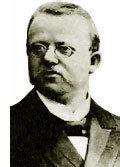Nationality German Role Author | Academic advisors Karl Westphal Name Hermann Oppenheim | |
 | ||
Died May 5, 1919, Berlin, Germany | ||
Hermann Oppenheim (1 January 1858 – 5 May 1919) was one of the leading neurologists in Germany.
He studied medicine at the Universities of Berlin, Göttingen and Bonn. He started his career at the Charité-Hospital in Berlin as an assistant to Karl Westphal (1833–1890). In 1891 Oppenheim opened a successful private hospital in Berlin.
In 1894, Oppenheim was the author of a textbook on nervous diseases titled Lehrbuch der Nervenkrankheiten für Ärzte und Studierende, a book that soon became a standard in his profession. It was published in several editions and languages, and is considered one of the best textbooks on neurology ever written. He also published significant works on tabes dorsalis, alcoholism, anterior poliomyelitis, syphilis, multiple sclerosis and traumatic neurosis. In the field of physiology, he published articles on metabolism of urea with the aid of Nathan Zuntz (1847–1920).
In 1889 he published a treatise on traumatic neuroses that was harshly criticized by eminent physicians that included Jean-Martin Charcot (1825–1893) and Max Nonne (1861–1959); the reason being due to Oppenheim's assertion that psychological trauma caused organic changes that perpetuated psychic neuroses.
His expertise involving brain disease led directly to the first successful removal of a brain tumor, an operation that was performed by a physician named R. Köhler. With surgeon Fedor Krause (1857–1937), he reported the first successful removal of a pineal tumor.
He coined the term "dystonia musculorum deformans" for a type of childhood torsion disease he described, a disorder that was later to become known as "Ziehen-Oppenheim syndrome" (named along with German psychiatrist Theodor Ziehen 1862–1950). Also, another name for amyotonia congenita is "Oppenheim's disease".
